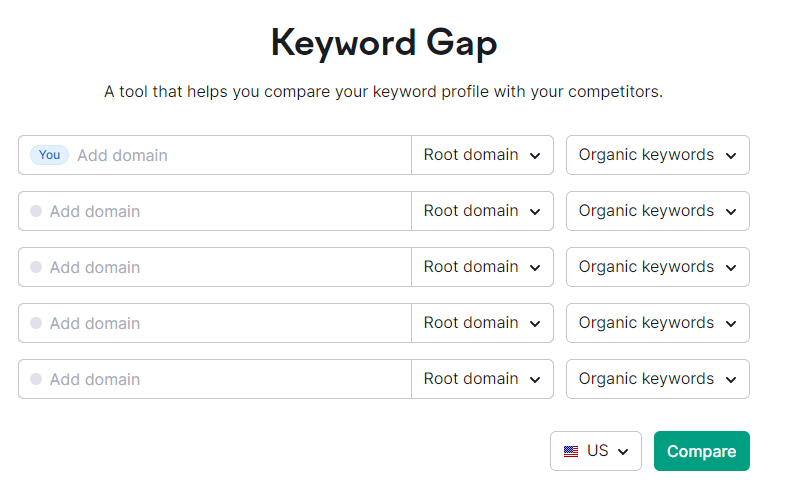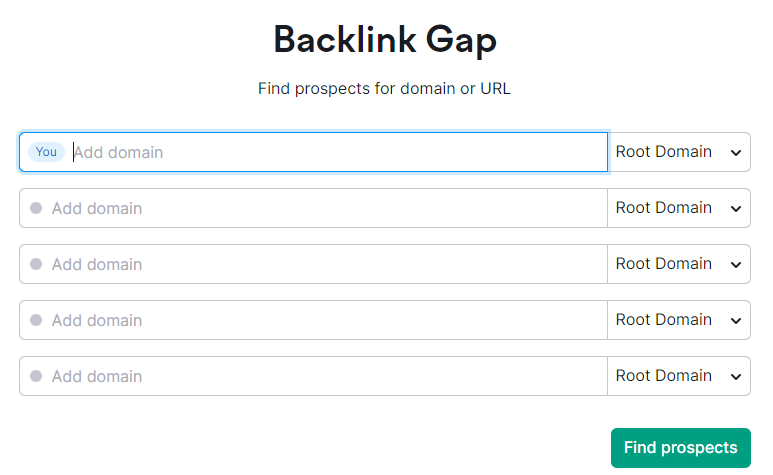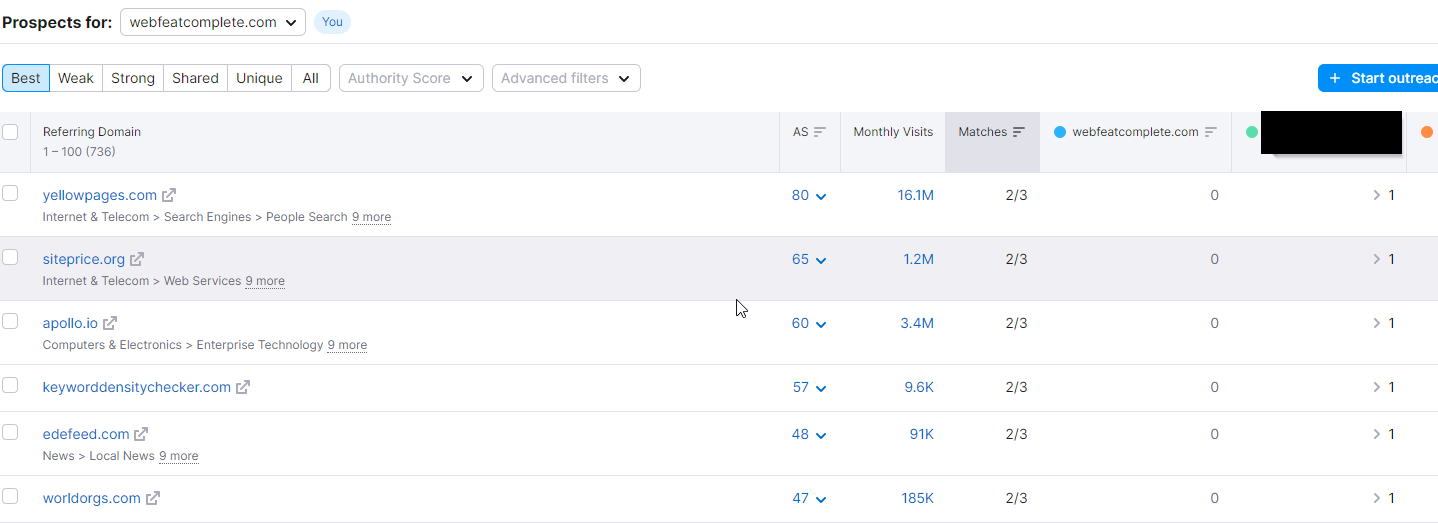Sometimes when you’re seeking a solution to a question or problem, the answer can be right in front of you.
This holds true with SEO.
When you’re searching for the right keywords to target and other opportunities to expand your reach, why not look at the search results where you’re aiming to be? You’ll find competitors you’re aware of, unaware of, maybe some ads, “people also ask”, related searches and so much more information.
Honing in on the competitors that are ranking well is an opportunity to learn and gather insights for targeting enhancement, content, and backlink opportunities. These efforts ultimately can lead to better rankings, more traffic, and most importantly more leads/sales.
Here’s a bit of what we do here at webFEAT Complete to help our clients gain a competitive edge.
SEMrush Competitor Keyword Gap Analysis
A competitor keyword gap analysis is a fancy way of saying: We’re taking a look at the search phrases you rank for vs. those that your competitor(s) rank for.
SEMrush makes this easy with the Keyword Gap Tool.
All you have to do is enter your domain, and up to 4 competitor domains, then click “Compare”.

This will spit out a table showing you the phrases everyone is ranking for, and how everyone’s rankings differ.

You can export this to an excel sheet to clean up the data, and begin to gather insights.
We place focus on:
- Relevant phrases competitors are ranking for, that we are not
- High Value/Key phrases where competitors are outranking us
I like to sort the sheet by search volume and color code for if the search phrase is, might be, or is not a relevant target. Once we curate the data and have specific target search phrases in the above categories, we can take a look at our site content and meta information.
Developing Action Items:
- It is likely that if we’re not ranking for something at all, we don’t have content on it. Therefore, content needs to be added to an existing page, or a new page/post should be created
- If we’re simply being outranked, we need to look into meta information/H1 verbiage, enhancing content, and potentially earning some backlinks (competitor backlinks up next!)
Tracking your progress-What to keep an eye on:
- Growth in the number of search phrases you’re appearing for in the search results (search console)
- Growth in the number of search phrases you’re appearing for in the top 50 (search console or SpyFu)
- Growth in impressions, appearances in search (search console)
- Growth in clicks from search to your content (search console)
- Better engagement metrics (bounce rate, time spent on site, number of pages viewed) on improved content (analytics)
- Good engagement metrics on new content (analytics). Pages with a high bounce rate, low time spent on the page, and lack of continuing through the funnel will prompt some additional work
EXAMPLE:
I’m writing this post in March, so a fitting seasonal marketing example might be a tax preparation company.
To continue growing, or turn a downtrend around we could do some SEO and content marketing in association with a keyword gap analysis.
We run through the process and gather a couple of takeaways and associated action items:
- Prospects have questions about cryptocurrency in association with taxes
- Create a blog post covering general information and FAQ’s regarding Cryptocurrency Tax Forms and Reporting
- There is an interest in business taxes
- You lightly mention business taxes on your main page, but don’t have a dedicated business taxes page. Separate individual and business, and build up relevant, specific content around each type of tax preparation. Consider the questions prospects may have, explore the search results for ways you can beef up content
- We’re being outranked on the key phrase “Individual Tax Preparation [local city]”. With this phrase, there are also ads and a map coming up that limit our ability to appear even if we are ranking #1
- Run Google Guaranteed ads on specific topics/services
- Improve individual tax preparation page (content, headings, meta information, internal linking)
- add more mentions of tax preparation throughout the site
- get listed and claim profiles for tax prep/CPA directories and listings
SEMrush Competitor Backlink Gap Analysis
A competitor backlink gap analysis is a fancy way of saying: We’re taking a look at the backlinks you have vs. those that your competitor(s) have.
Again, SEMrush makes this easy with their backlink gap tool.
All you have to do is enter your domain, and up to 4 competitor domains, then click “Find Prospects”.

This will spit out a table showing you shared backlinks and backlinks your competitors have that you don’t.

You can export this to an excel sheet to curate quality backlinks and take notes on those you’re pursuing. Again, color coding can be really effective.
We place focus on:
- High authority/volume backlinks
- Relevant domains/content on the domain where we can earn a backlink
- Domains/Listings/Directories that come up in key searches
Developing Action Items:
- Create or claim listings/directories, and update them
- If there are articles where competitors are mentioned and you’re not (for example, a “best of 2023” companies list-reach out to the editor to see what you can do to be there next year
- Rule out spammy domains
- Consider also running the backlink audit tool, and submitting a disavow file to Google if you have a lot of highly toxic backlinks
Tracking your progress-What to keep an eye on:
- Referral traffic from recently earned backlinks, and the quality of that traffic
- All of the progress metrics mentioned in the keyword gap above apply. Backlinks and mentions usually have a positive impact on many metrics over time
EXAMPLE:
Let’s say you’re a semi-new restaurant, about a year old. You want to be discussed in your city, have listings where your competitors do, and pursue mentions in articles.
You run a competitor backlink gap on a few competitors and go through the process.
Some takeaways:
- Although you don’t like it, Yelp is coming up on every search relevant to your restaurant (dinner Cincinnati, lunch near downtown, etc) and your competitors have backlinks there. You do not currently have a listing there
- Create Yelp listing that is fully updated, utilizing all free functionalities
- Test Yelp Ads
- You notice that your competitors are mentioned in online magazines and “Best of Cincinnati” lists
- Reach out to authors/editors to invite them in for a meal, request feedback in attempt to get an article, or be top of mind for the “best of” next year
- Competitors are involved with providing sponsorships that are earning backlinks/mentions on websites and social media
- Get involved with charity and sponsorships to get involved in the community, help, and earn backlinks
- Ramp up social media engagement with businesses and groups around the city
- Ensure you have all social media platforms built out, and in use
Search Results/Competitor Ads
Looking at the search results as a starting point to gather competitors is important, but it’s also important to dive in and take a broad look at what’s going on in the search results.
What are searchers interested in? What follow-up/related questions do they have?
Search your brand name and important phrases-are other businesses bidding on them?
On key searches, are ads coming up (Search Text, Map, Google Guaranteed)?
On key searches, are certain listings/directories coming up?
All of these questions need to be answered and considered with your overarching strategy.
If you’re ranking #1 but there are so many ads, maps, and other ads coming up that prospects don’t even scroll to organic listings-you’ll be missing out on leads. Unfortunately, in some circumstances, you have to have ads, and/or hone in on your local SEO and map presence.
If you want to make ranking and traffic gains, gather competitive insights and leverage them
We can help you identify and act on those opportunities!
Get the conversation started by scheduling a meeting or filling out our short form.

